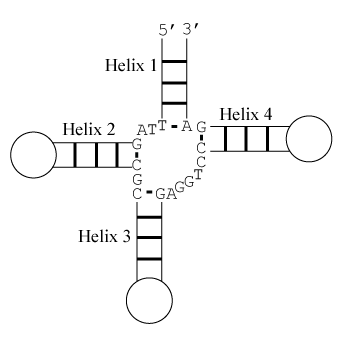29 Multibranch Loops
29.1 Folding Free Energy Change
Multibranch loops stabilities are predicted using the following equation:
ΔG°37 multibranch = ΔG°37 initiation + ΔG°37 stacking
where the stacking is the optimal configuration of dangling ends, terminal mismatches, or coaxial stacks, noting that each nucleotide or helix end can participate in only one of these favorable interactions.
The initiation is predicted using:
ΔG°37 initiation = a + b×[number of unpaired nucleotides] + c×[number of branching helices]
where a, b, and c are parameters.
29.2 Folding Enthalpy Change
Similar to free energy change, multibranch loops enthalpy changes are predicted using the following equation:
ΔH°multibranch = ΔH°initiation + ΔH°stacking
where the stacking is the configuration of dangling ends, terminal mismatches, or coaxial stacks with lowest folding free energy change.
Initiation is predicted using an equation analagous to that folding free energy initiation:
ΔH°initiation = a + b×[number of unpaired nucleotides] + c×[number of branching helices]
29.3 Examples

Free Energy Change
Prediction of Stacking
The predicted stacking configuration is the one with lowest free energy change. There are eight relevant configurations.
Configuration 1:
Helix 1 with \(3'\) dangling T, Helix 2 with terminal mismatch, Helix 3 with \(3'\) dangling A, and Helix 4 with \(5'\) dangling C
ΔG°37 = ΔG°37(TA with \(3'\) dangling T) + ΔG°37(CG followed by GA) + ΔG°37(GC with \(3'\) dangling A) + ΔG°37(GC with \(5'\) dangling C)
ΔG°37 = -0.2 kcal/mol - 1.0 kcal/mol - 0.4 kcal/mol - 0.5 kcal/mol
ΔG°37 = -2.1 kcal/mol
Configuration 2:
Helix 1 with \(3'\) dangling T, Helix 2 with \(5'\) dangling A, Helix 3 with terminal mismatch, and Helix 4 with \(5'\) dangling C
ΔG°37 = ΔG°37(TA with \(3'\) dangling T) + ΔG°37(CG with \(5'\) dangling A) + ΔG°37(GC followed by AG) + ΔG°37(GC with \(5'\) dangling C)
ΔG°37 = -0.2 kcal/mol - 0.8 kcal/mol - 0.8 kcal/mol - 0.5 kcal/mol
ΔG°37 = -2.3 kcal/mol
Configuration 3:
Helix 1 in flush coaxial stack with helix 4, Helix 2 with terminal mismatch, and Helix 3 with \(3'\) dangling A
ΔG°37 = ΔG°37(GC followed by AT) + ΔG°37(CG followed by GA) + ΔG°37(GC with \(3'\) dangling A)
ΔG°37 = 0.0 kcal/mol - 1.0 kcal/mol - 0.4 kcal/mol
ΔG°37 = -1.4 kcal/mol
Configuration 4:
Helix 1 in flush coaxial stack with helix 4, Helix 2 with \(5'\) dangling A, and Helix 3 with terminal mismatch
ΔG°37 = ΔG°37(GC followed by AT) + ΔG°37(CG with \(5'\) dangling A) + ΔG°37(GC followed by AG)
ΔG°37 = -1.3 kcal/mol - 0.8 kcal/mol - 0.8 kcal/mol
ΔG°37 = -2.9 kcal/mol
Configuration 5:
Helix 1 with \(3'\) dangling T, Helix 2 in mismatch–mediated coaxial stack with helix 3 with GA intervening mismatch, and Helix 4 with \(5'\) dangling C
ΔG°37 = ΔG°37(TA with \(3'\) dangling T) + ΔG°37(CG followed by GA) + ΔG°37(Discontinuous Backbone Stack) + ΔG°37(GC with \(5'\) dangling C)
ΔG°37 = -0.2 kcal/mol - 1.0 kcal/mol - 2.1 kcal/mol - 0.5 kcal/mol
ΔG°37 = -3.8 kcal/mol
Configuration 6:
Helix 1 with \(3'\) dangling T, Helix 2 in mismatch–mediated coaxial stack with helix 3 with AG intervening mismatch, and Helix 4 with \(5'\) dangling C
ΔG°37 = ΔG°37(TA with \(3'\) dangling T) + ΔG°37(Discontinuous Backbone Stack) + ΔG°37(GC followed by AG) + ΔG°37(GC with \(5'\) dangling C)
ΔG°37 = -0.2 kcal/mol - 2.1 kcal/mol - 0.8 kcal/mol - 0.5 kcal/mol
ΔG°37 = -3.6 kcal/mol
Configuration 7:
Helix 1 in flush coaxial stack with helix 4 and Helix 2 in mismatch–mediated coaxial stack with helix 3 with GA intervening mismatch
ΔG°37 = ΔG°37(GC followed by AT) + ΔG°37(CG followed by GA) + ΔG°37(Discontinuous Backbone Stack)
ΔG°37 = -1.3 kcal/mol - 1.0 kcal/mol - 2.1 kcal/mol
ΔG°37 = -4.4 kcal/mol
Configuration 8:
Helix 1 in flush coaxial stack with helix 4 and Helix 2 in mismatch–mediated coaxial stack with helix 3 with AG intervening mismatch
ΔG°37 = ΔG°37(GC followed by AT) + ΔG°37(Discontinuous Backbone Stack) + ΔG°37(GC followed by AG)
ΔG°37 = -1.3 kcal/mol - 2.1 kcal/mol - 0.8 kcal/mol
ΔG°37 = -4.2 kcal/mol
Configuration 7 has the lowest folding free energy change of -4.4 kcal/mol.
Initiation Free Energy Change
ΔG°37 initiation = a + b×[number of unpaired nucleotides] + c×[number of branching helices]
ΔG°37 initiation = 3.0 kcal/mol + 0.2 kcal/mol × 8 + 0.2 kcal/mol × 4
ΔG°37 initiation = 5.4 kcal/mol
Total Folding Free Energy Change
ΔG°37 multibranch loop = ΔG°37 initiation + ΔG°37 stacking = -4.4 kcal/mol + 5.4 kcal/mol = 1.0 kcal/mol
Enthalpy Change
Prediction of Stacking
The stacking configuration is fixed by the prediction of folding free energy change and is configuration 7 above.
ΔH°= ΔH°(GC followed by AT) + ΔH°(CG followed by GA) + ΔH°(Discontinuous Backbone Stack)
ΔH° = -8.5 kcal./mol - 4.6 kcal/mol - 8.4 kcal/mol
ΔH° = -21.5 kcal/mol
Initiation Enthalpy Change
ΔH°initiation = a + b×[number of unpaired nucleotides] + c×[number of branching helices]
ΔH°initiation = 9.0 kcal/mol + 0.0 kcal/mol × 8 + 0.0 kcal/mol × 4
ΔH°initiation = 9.0 kcal/mol
Total Folding Enthalpy Energy Change
ΔH°multibranch loop = ΔH°initiation + ΔH°stacking
ΔH°multibranch loop = 9.0 kcal/mol - 21.5 kcal/mol = -12.5 kcal/mol
Note that helices 1 and 2 are separated by two unpaired nucleotides and cannot stack coaxially. Similarly, helices 3 and 4 are too distant to stack coaxially. Also note that coaxial stacking is only allowed between adjacent helices and hence, for example, helices 1 and 3 cannot stack coaxially.
29.4 Parameter Tables
Tables of parameters are available in html format.
